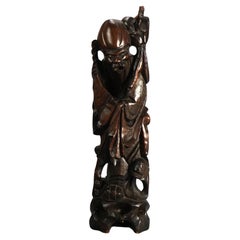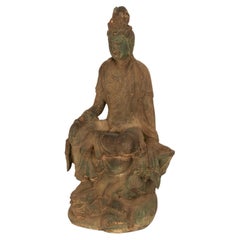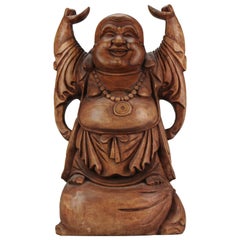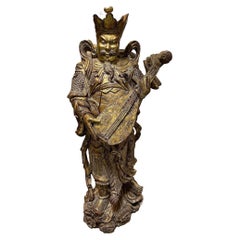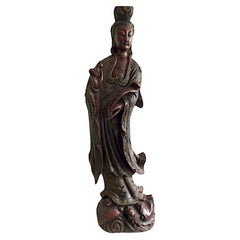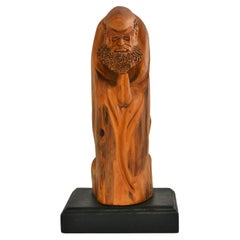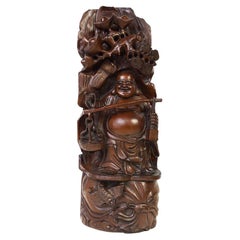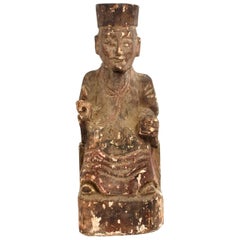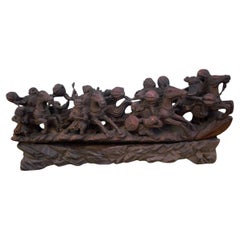Carved Wood Statues
Early 20th Century Sculptures and Carvings
Wood
Antique 18th Century Chinese Qing Sculptures and Carvings
Wood
20th Century Chinese Sculptures and Carvings
Wood
Early 20th Century Sculptures and Carvings
Wood
Vintage 1920s Sculptures and Carvings
Wood
20th Century Chinese Sculptures and Carvings
Wood
Early 20th Century Chinese Chinese Export Sculptures and Carvings
Boxwood
Antique Early 19th Century Chinese Sculptures and Carvings
Wood
Mid-20th Century Asian Rustic Sculptures and Carvings
Wood
20th Century Indian Tribal Sculptures and Carvings
Wood
Antique Early 19th Century Chinese Sculptures and Carvings
Wood
Late 20th Century Sculptures and Carvings
Wood
Antique 19th Century Sculptures and Carvings
Wood
Antique 19th Century Chinese Sculptures and Carvings
Wood
Early 20th Century Sculptures and Carvings
Hardwood, Paint
Antique 19th Century Japanese Edo Sculptures and Carvings
Gold Leaf
Antique 19th Century Southeast Asian Sculptures and Carvings
Wood, Lacquer
Antique 19th Century Sculptures and Carvings
Wood
Antique Late 19th Century Korean Folk Art Sculptures and Carvings
Wood, Giltwood, Lacquer
Antique Mid-19th Century Balinese Rustic Sculptures and Carvings
Glass, Wood, Paint
Antique 19th Century Burmese Sculptures and Carvings
Wood
Mid-20th Century Burmese Sculptures and Carvings
Wood
Antique Late 19th Century Burmese Sculptures and Carvings
Wood
Antique 19th Century Burmese Rustic Sculptures and Carvings
Glass, Wood, Lacquer
20th Century Chinese Chinese Export Sculptures and Carvings
Wood
Early 20th Century Indian Sculptures and Carvings
Wood
Mid-20th Century Thai Sculptures and Carvings
Wood
Early 20th Century Indian Figurative Sculptures
Wood
20th Century Unknown Chinese Export Sculptures and Carvings
Wood
20th Century Indian Sculptures and Carvings
Wood
2010s Afghan Figurative Sculptures
Lapis Lazuli
Early 20th Century Indian Sculptures and Carvings
Wood
Mid-20th Century Chinese Other Sculptures and Carvings
Wood, Paint
Antique 18th Century Chinese Ming Sculptures and Carvings
Wood
Early 20th Century Indian Sculptures and Carvings
Wood
Early 20th Century Indian Sculptures and Carvings
Wood
Early 20th Century Southeast Asian Folk Art Sculptures and Carvings
Cut Glass, Wood, Giltwood, Lacquer
Early 20th Century Indonesian Sculptures and Carvings
Wood
Late 20th Century Sculptures and Carvings
Hardwood
Antique Mid-17th Century Japanese Edo Animal Sculptures
Wood
20th Century Sculptures and Carvings
Wood
Antique 19th Century Burmese Sculptures and Carvings
Wood
Antique 1770s Japanese Sculptures and Carvings
Gesso, Wood
20th Century Chinese Tang Sculptures and Carvings
Wood
Late 20th Century Sculptures and Carvings
Wood
20th Century Chinese Qing Sculptures and Carvings
Wood
Early 20th Century Burmese Other Sculptures and Carvings
Wood, Teak
Early 20th Century Indonesian Tribal Tribal Art
Wood
20th Century Antiquities
Wood
Antique 16th Century Japanese Sculptures and Carvings
Gesso, Wood
2010s Afghan Figurative Sculptures
Lapis Lazuli
Mid-20th Century Indonesian Other Animal Sculptures
Wood, Paint
Antique 17th Century Burmese Sculptures and Carvings
Wood
Early 20th Century Japanese Meiji Sculptures and Carvings
Wood, Paint, Lacquer, Giltwood
Antique 18th Century Burmese Sculptures and Carvings
Wood
Early 20th Century Burmese Sculptures and Carvings
Wood
Antique 18th Century Chinese Sculptures and Carvings
Wood
Early 2000s Thai Other Sculptures and Carvings
Wood
20th Century Chinese Sculptures and Carvings
Wood
Early 20th Century Indian Figurative Sculptures
- 1
Carved Wood Statues For Sale on 1stDibs
How Much are Carved Wood Statues?
Finding the Right Sculptures And Carvings for You
Asian sculptors have worked in materials including wood, bronze and jade. Artists and artisans have used traditional techniques to depict deities, scenes from culture and more, and today, antique Asian sculptures and carvings are a popular choice for provocative and sophisticated home decor.
In China, the Qing dynasty, from the mid-17th century to the early 20th century, brought about significant changes in art while preserving traditional culture. Many emperors during this period were patrons of the arts, such as painting, calligraphy and decorative arts. This era saw the building of new Buddhist temples, which were decorated with statues. Some of these sculptures were adorned with colorful cloisonné decoration, in which tiny compartments, or cloisons, made by soldering copper filaments to a metal surface were filled with vibrantly hued enamel.
From the 17th to mid-19th century in Japan, kimonos were worn across classes and often fastened with a netsuke, a type of small carved toggle. Artists carved these from ivory, wood, shells and coral, creating animals, flowers and mythical creatures. During the Japanese Meiji period, spanning from 1868–1912, the country began trading internationally after centuries of isolation, allowing artists to sell their work overseas. Bronze sculpture flourished around this time for creating teapots, vases and incense burners.
Asian sculpture continued to evolve in the 20th century. During the Japanese Shōwa era, from 1926–89, art was influenced by international modernist movements like abstraction, Futurism and Surrealism. Contemporary Asian sculptures and carvings continue to combine global influences and a rich heritage of technique.
Decorating a space with Asian sculptures and carvings is a great way to add interest to any corner of your home. Explore by material, period or style on 1stDibs.
- What is Jepara wood carving?1 Answer1stDibs ExpertApril 5, 2022Jepara wood carving is the intricate wood carving art that comes from the city of Jepara in Indonesia. Artisans typically work with teak wood to create beautiful carved detail and scenes in a piece of furniture. Shop a collection of Jepara wood carvings on 1stDibs.
- What is a Paete wood carving?1 Answer1stDibs ExpertMay 5, 2023A Paete wood carving is a decorative wooden object produced by artisans in Paete, Philippines. In 2005, the village was officially dubbed the Woodcarving Capital of the Philippines due to the intricate sculptures and statues produced there. Shop a variety of wood art from some of the world’s top galleries on 1stDibs.
- What is Chinese wood carving?1 Answer1stDibs ExpertApril 5, 2022A Chinese wood carving is a decorative object carved by hand by Chinese artisans out of local wood, such as nanmu, zitan, bomu or yinxing. This form of sculpture is sometimes called mudiao. On 1stDibs, find a range of Chinese wood carvings.
- What is Japanese wood carving?1 Answer1stDibs ExpertApril 5, 2022Japanese wood carving is an art form in which artists produce intricate figurines and other objects by cutting and shaping blocks of zelkova, camphor or paulownia wood. In Japanese, the artwork is known as inami. Find a selection of Japanese wood carvings on 1stDibs.
- 1stDibs ExpertNovember 4, 2024To identify wood carvings, get a magnifying glass and inspect your items. Some artisans marked their carvings with symbols or signed them. Researching any markings found on your carving may allow you to identify the maker who produced it and potentially learn more about the piece from there. If you're unable to find a maker's mark, the best approach is likely to use the services of a certified appraiser or other knowledgeable expert. On 1stDibs, explore a selection of wood carvings.
- 1stDibs ExpertApril 5, 2022There are many methods and types of wood carving, including chip, relief, Scandinavian flat-plane, lovespoon, whittling and florentine. Each type uses different tools and can create decorative carvings on both display pieces and furniture. Browse a wide range of carved wood pieces on 1stDibs.
- What is carved wood art called?1 Answer1stDibs ExpertMarch 3, 2023What carved wood art is called depends on the type of piece. Three-dimensional pieces created by hand-carving wood are whittlings, while carvings into a flat piece of wood are reliefs. Shop a collection of wood art from some of the world's top galleries on 1stDibs.
- 1stDibs ExpertApril 5, 2022Antique carved wood can be identified by how it is made. Antique carvings were done by hand, so nicks and cuts will indicate carvings completed with a plane or knife. In addition, hand-carved wood will not be uniform or have perfect symmetry. Always works with a certified appraiser to determine the exact date and value of an item. Find a variety of antique carved wood furniture and decor on 1stDibs.
- 1stDibs ExpertJune 15, 2023To tell if wood is hand-carved, first look for small marks in the wood that indicate hand tools were used to cut and shape the material. Hand-carved pieces may also have small irregularities, particularly along curved areas. However, it may be very difficult to tell the difference between machine-worked and hand-carved pieces in some cases. On 1stDibs, shop a range of wood furniture and decorative objects.
- 1stDibs ExpertApril 5, 2022In Bali, Indonesia, Jackfruit is considered the best wood when it comes to carving. Jackfruit is a medium hardwood, resistant to termite attacks and is easy to polish. You’ll find a variety of Indonesian carvings from some of the world’s top sellers on 1stDibs.
- 1stDibs ExpertMarch 31, 2023What wood is used for African wood carvings varies. Iroko, mahogany and ebony are frequently chosen materials, but artisans may choose to work with whatever wood is available in their local areas. Shop a variety of African wood art from some of the world's top galleries on 1stDibs.
- 1stDibs ExpertOctober 19, 2021The difference between carving and sculpture is that carving is a carved object, whereas sculpture is the art of shaping figures or designs — because sculpture can involve adding material (i.e., working with plaster, creating a mold to be cast in bronze), it is considered “additive” versus the “subtractive” act of carving.
- 1stDibs ExpertApril 5, 2022In Bali, many different types of woods are used for carving. Some examples include albesia, crocodile wood, rain tree, hibiscus, jackfruit, teak, mahogany and sandalwood. On 1stDibs, you can shop a range of Balinese wood art, furniture and decorative objects.
- 1stDibs ExpertApril 5, 2022Carved African wood figurines were typically spiritual in nature and were primarily in human form. The wood figurines were carved using ebony, teak, mahogany and iron wood. On 1stDibs, find a collection of authentic African wood figurines from some of the world’s top sellers.
Read More
Chicago’s Pagoda Red Has a Spirited Mix of Asian Antiques and Bold New Art
For 25 years, gallerist Betsy Nathan has leveraged her keen eye and key connections to bring a unique selection of rare finds to the market.
In L.A., Gallerist JF Chen Has Long Championed Eclectic Blue-Chip Design
Now working alongside his daughter Bianca, dealer Joel Chen has presented a most covetable array of antiques, art and contemporary creations for more than 40 years.
12 Calming Spaces Inspired by Japanese Design
From cherry-blossom-adorned walls paired with glamorous lighting to wood-paneled ceilings above checkerboard-patterned chairs, these 12 spaces seamlessly blend Eastern and Western aesthetics.
Rodrigo Rivero Lake’s Mexico City Showroom Is a Museum-Worthy Trove of Spanish Colonial and Asian Antiques
The dealer and curator has spent the past 50 years amassing a collection of exceptional art, furniture and architectural elements that trace the cultural influence of the Spanish empire from Europe to the Americas and beyond.
16 Refined Asian-Inspired Interiors
These spaces exemplify how Eastern elements elevate a home's decor.
